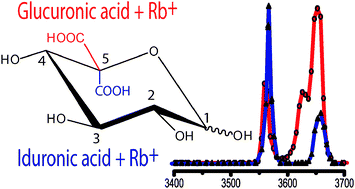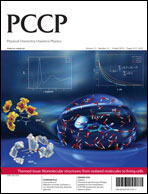Gas-phase binding of the alkali metal Rb+ to two monosaccharide isomers, glucuronic acid (GlcA) and iduronic acid (IdoA), is investigated by infrared photodissociation spectroscopy. The infrared spectra display striking differences, exemplified by the clear absence of a band at 3625 cm−1 in the case of IdoA + Rb+. Comparison of the experimental spectra to computed spectra of DFT-optimized structures suggests that Rb+-tagged GlcA and IdoA each adopt their own distinctive complexation pattern. For GlcA, mainly the β-anomer 4C1 chair complex is observed, whereas for IdoA the data are consistent with the α-anomer 1C4 chair structure, as well as the corresponding β-anomer. The differences in the Rb+ binding motif rationalize the disparities in the infrared multiple-photon dissociation (IR-MPD) spectra. Whereas Rb+ binding to GlcA leaves the intramolecular hydrogen-bonding network between the OH groups intact, this network is disrupted for IdoA. The lack of stronger hydrogen-bonding for IdoA + Rb+ thus correlates well with the absence of the red-shifted OH stretch band at 3625 cm−1.

You have access to this article
 Please wait while we load your content...
Something went wrong. Try again?
Please wait while we load your content...
Something went wrong. Try again?


 Please wait while we load your content...
Please wait while we load your content...